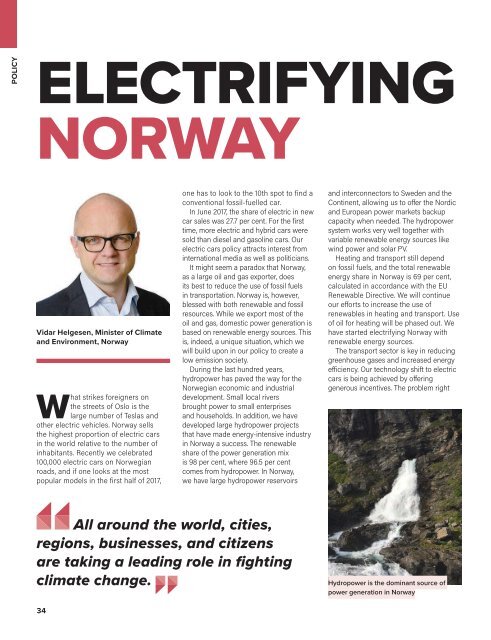Climate Action 2017-2018
You also want an ePaper? Increase the reach of your titles
YUMPU automatically turns print PDFs into web optimized ePapers that Google loves.
POLICY<br />
ELECTRIFYING<br />
NORWAY<br />
Vidar Helgesen, Minister of <strong>Climate</strong><br />
and Environment, Norway<br />
What strikes foreigners on<br />
the streets of Oslo is the<br />
large number of Teslas and<br />
other electric vehicles. Norway sells<br />
the highest proportion of electric cars<br />
in the world relative to the number of<br />
inhabitants. Recently we celebrated<br />
100,000 electric cars on Norwegian<br />
roads, and if one looks at the most<br />
popular models in the first half of <strong>2017</strong>,<br />
one has to look to the 10th spot to find a<br />
conventional fossil-fuelled car.<br />
In June <strong>2017</strong>, the share of electric in new<br />
car sales was 27.7 per cent. For the first<br />
time, more electric and hybrid cars were<br />
sold than diesel and gasoline cars. Our<br />
electric cars policy attracts interest from<br />
international media as well as politicians.<br />
It might seem a paradox that Norway,<br />
as a large oil and gas exporter, does<br />
its best to reduce the use of fossil fuels<br />
in transportation. Norway is, however,<br />
blessed with both renewable and fossil<br />
resources. While we export most of the<br />
oil and gas, domestic power generation is<br />
based on renewable energy sources. This<br />
is, indeed, a unique situation, which we<br />
will build upon in our policy to create a<br />
low emission society.<br />
During the last hundred years,<br />
hydropower has paved the way for the<br />
Norwegian economic and industrial<br />
development. Small local rivers<br />
brought power to small enterprises<br />
and households. In addition, we have<br />
developed large hydropower projects<br />
that have made energy-intensive industry<br />
in Norway a success. The renewable<br />
share of the power generation mix<br />
is 98 per cent, where 96.5 per cent<br />
comes from hydropower. In Norway,<br />
we have large hydropower reservoirs<br />
and interconnectors to Sweden and the<br />
Continent, allowing us to offer the Nordic<br />
and European power markets backup<br />
capacity when needed. The hydropower<br />
system works very well together with<br />
variable renewable energy sources like<br />
wind power and solar PV.<br />
Heating and transport still depend<br />
on fossil fuels, and the total renewable<br />
energy share in Norway is 69 per cent,<br />
calculated in accordance with the EU<br />
Renewable Directive. We will continue<br />
our efforts to increase the use of<br />
renewables in heating and transport. Use<br />
of oil for heating will be phased out. We<br />
have started electrifying Norway with<br />
renewable energy sources.<br />
The transport sector is key in reducing<br />
greenhouse gases and increased energy<br />
efficiency. Our technology shift to electric<br />
cars is being achieved by offering<br />
generous incentives. The problem right<br />
All around the world, cities,<br />
regions, businesses, and citizens<br />
are taking a leading role in fighting<br />
climate change.<br />
Hydropower is the dominant source of<br />
power generation in Norway<br />
34












